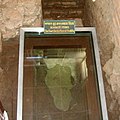Lumbini

Lumbini ( Nepali लुम्बिनी Lumbinī today Rummindai ) is after the first oral tradition the birthplace of Siddhartha Gautama , the founder of Buddhism . The place is only a few kilometers north of the border with India in the urban area of Lumbini Sanskritik in today's Nepal ( Rupandehi district ). The pilgrimage center with its Peace Park was classified as a World Heritage Site by UNESCO in 1997 .
Legend and history
In the vicinity of the Mayadevi Temple excavations were carried out at the beginning of the 21st century, the results of which date back to well into the 1st millennium BC. Close the religious and sacred tradition of the place that goes back to BC. The remains of a wooden structure (temple?) From the 6th century BC were found under today's temple. BC, which is considered by archaeologists to be the oldest known shrine of Buddha.
Maya , the mother of the Buddha, is said to have given birth to her son on a trip to see her parents - standing and holding onto the branches of a tree with her hands; a few days later she died. However, Siddharta Gautama , as the boy was called, spent his childhood and youth in the palace of his father Shuddhodana in Kapilavastu .
Around the year 245 BC BC, about 250 years after the controversial year of Buddha's death, King Ashoka had a 6.50 m high stone column with an inscription built (see: Edicts of Ashoka ). The inscription written in Brahmi reads:
- “Twenty years after his coronation, King Devanampiya Piyadasi ( Ashoka ) came here and showed his admiration because the Buddha, the sage of the Shakya clan ('shakyamuni'), was born here. He had a stone fence made and a stone pillar erected to indicate that the Blessed One ('bhagawan') was born here. He exempted the village of Lumbini from taxes and (set) his taxes in kind (from the usual quarter) to one eighth. "
The designation of Buddha as Shakyamuni has aroused suspicion, as the earliest use of this honorary name is only known from the 1st century AD.
Lumbini was visited by the two Chinese monks Faxian (around 400 AD) and Xuanzang (around 650) on their travels through northern India. Xuanzang mentions a horse capital on the Ashoka column, which may have been destroyed by lightning; the inscription is not mentioned by either of them, which may be due to the fact that it was perhaps even then hidden below ground level.
The place was founded in 1896 a. a. archaeologically rediscovered by the German Indologist Alois Anton Führer . However, since large parts of his writings have been exposed as plagiarism or even falsification, his information should be viewed with caution.
Bodhi tree and pond in Lumbini
Pillar of Ashoka
Attractions
There are numerous pagodas and temples from various Buddhist countries in Asia on the grounds of the Peace Park in Lumbini .
Maitreya temple
See also
Other significant Buddhist sites in the Lumbini area include:
literature
- Way, Kai u. a .: The Sacred Garden of Lumbini - Perceptions of Buddha's Birthplace ( Memento from August 30, 2014 in the Internet Archive ), UNESCO, Paris 2013
- TA Phelps: Lumbini On Trial: The Untold Story. 2008
Web links
- Lumbini, Ashoka Pillar - Photos and inscription text (English)
- Lumbini, Ashoka Pillar - Photos and inscription text (English)
- Lumbini - video with aerial shots
- Lumbini - Video (English)
- Lumbini - Photos of the temple complex
Individual evidence
- ↑ Entry on the website of the UNESCO World Heritage Center ( English and French ).
- ↑ RAE Coningham et al. a .: The earliest Buddhist shrine: excavating the birthplace of the Buddha, Lumbini (Nepal). Durham University 2013 ( December 5, 2014 memento on the Internet Archive )
- ↑ Did Buddha live earlier than expected? ( July 24, 2016 memento on the Internet Archive ) 2013 National Geographic article.
Coordinates: 27 ° 29 ′ 0 ″ N , 83 ° 17 ′ 0 ″ E












